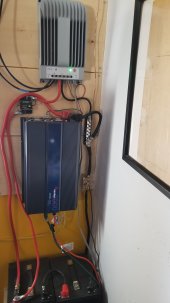Recently switched from a 40amp BN series to the 8415 AN on Thursday night after my 40amp was possibly borked due to user error.
My current setup is four 320w panels (2s2p), the Tracer AN 80 amp mppt, two 100ah SOK batteries in series for 24v, and a 2000W Samlex inverter.
On Friday (first day using new controller), thr PV would still periodically cut out in cold, bright conditions as amps in would rise (was having this issue on the 40a but thought it was the controller) but never any warning light on the indicator. I put shade cloth over panels to limit these conditions while I tried to troubleshoot what was going on. One guess was bad MC4 connections after a severe ice storm, new ones are ordered to see if that solves the cutting out issue.
Saturday during the day was much the same, I was constantly monitoring the charging output on the MT-50 and it was functioning properly so long as the PV didn't cut out. On one such cut I briefly saw the red indicator but it cleared before I got a look at the screen. I fully covered the panels at this point to prevent possible damage to my system.
This evening (sun had been down for hours, all was running as it should), my inverter alarm sounded for a dead battery and the controller indicated 11v from my battery bank. I replaced the battery lead from controller to breaker as reading the manual it seems it was too large. Turned the system back on, and all seemed well though the controller wouldn't auto detect the bank voltage. It read 26v, but all charge parameters were for 12v system. I factory reset, and it seemed to sort itself out.
A few hours later, same alarm. After again turning inverter off and flipping the breaker between controller and battery, I ran the following tests with my multimeter:
-As it was upon shutting down, battery read 11v at terminals
-disconnected everything from bank, battery reads 26v
-separated bank, batteries both read 13v
-reconnected inverter only, battery bank reads 26v / turn inverter on, battery bank reads 26v
-reconnect controller and inverter turning on immediately results in voltage drop.
-reconnect controller only, voltage held at 26v for a minute or so then dropped to 11v again.
It seems anytime the controller is attached to the bank, and any load is applied, the voltage plummets. Any ideas? I am flummoxed, frustrated, and hoping you all may have some suggestions for me after I try getting some sleep...
My current setup is four 320w panels (2s2p), the Tracer AN 80 amp mppt, two 100ah SOK batteries in series for 24v, and a 2000W Samlex inverter.
On Friday (first day using new controller), thr PV would still periodically cut out in cold, bright conditions as amps in would rise (was having this issue on the 40a but thought it was the controller) but never any warning light on the indicator. I put shade cloth over panels to limit these conditions while I tried to troubleshoot what was going on. One guess was bad MC4 connections after a severe ice storm, new ones are ordered to see if that solves the cutting out issue.
Saturday during the day was much the same, I was constantly monitoring the charging output on the MT-50 and it was functioning properly so long as the PV didn't cut out. On one such cut I briefly saw the red indicator but it cleared before I got a look at the screen. I fully covered the panels at this point to prevent possible damage to my system.
This evening (sun had been down for hours, all was running as it should), my inverter alarm sounded for a dead battery and the controller indicated 11v from my battery bank. I replaced the battery lead from controller to breaker as reading the manual it seems it was too large. Turned the system back on, and all seemed well though the controller wouldn't auto detect the bank voltage. It read 26v, but all charge parameters were for 12v system. I factory reset, and it seemed to sort itself out.
A few hours later, same alarm. After again turning inverter off and flipping the breaker between controller and battery, I ran the following tests with my multimeter:
-As it was upon shutting down, battery read 11v at terminals
-disconnected everything from bank, battery reads 26v
-separated bank, batteries both read 13v
-reconnected inverter only, battery bank reads 26v / turn inverter on, battery bank reads 26v
-reconnect controller and inverter turning on immediately results in voltage drop.
-reconnect controller only, voltage held at 26v for a minute or so then dropped to 11v again.
It seems anytime the controller is attached to the bank, and any load is applied, the voltage plummets. Any ideas? I am flummoxed, frustrated, and hoping you all may have some suggestions for me after I try getting some sleep...




